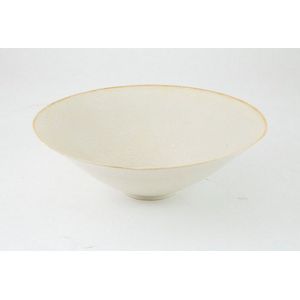Incised Blossom Bowl, Ding Ware, Song Dynasty
You must be a subscriber, and be logged in to view price and dealer details.
Subscribe Now to view actual auction price for this item
When you subscribe, you have the option of setting the currency in which to display prices to $Au, $US, $NZ or Stg.
- Song Dynasty - The Song Dynasty was a ruling dynasty in China from 960 to 1279 AD. It was divided into two periods, the Northern Song (960?1127) and the Southern Song (1127?1279). The emperor was the ultimate authority, but he relied on officials who were selected based on their merit and skills rather than their family background or social status. The Song Dynasty was a period of great artistic and cultural achievements, particularly in the areas of poetry, painting, and calligraphy. The Chinese invented the printing press during this period, which revolutionized the spread of knowledge and ideas. During the Song Dynasty, China had a prosperous economy and was a centre of international trade, particularly in luxury goods such as silk, tea, and porcelain. The use of paper money became more widespread during this period, facilitating commerce and trade.
- Chinese Ding Porcelain - Ding ware is a type of Chinese porcelain that was produced in the northern city of Ding in the Hebei province during the Song Dynasty (960-1279). It is considered to be one of the "Five Great Kilns" of Chinese ceramics, along with Jian, Jun, Guan, and Ru wares.
Ding ware is known for its fine white porcelain body, which was made from kaolin clay, and its elegant shapes and designs. The glaze on Ding ware is usually transparent and has a bluish-white or grayish-white color. It was often decorated with underglaze blue or iron-brown designs.
Ding ware was highly prized during the Song Dynasty, and it was exported throughout Asia and as far as the Middle East and the Mediterranean. It was also an inspiration for other porcelain-making centers in China and Japan. The production of Ding ware declined after the Song Dynasty, and it is now considered to be a rare and valuable collectible. - Incised - A record of a name, date or inscription, or a decoration scratched into a surface, usually of a glass or ceramic item with a blunt instrument to make a coarse indentation. Compare with engraving where the surface is cut with a sharp instrument such as a metal needle or rotating tool to achieve a fine indentation.
This item has been included into following indexes:
Visually similar items

A Chinese Qingbai bowl Song/Yuan Dynasty, the thinly potted bowl with a small footrim, and an unglazed mouthrim, with carved decoration of lotus petals to the exterior, covered in an even pale blue glaze, 5.5 cm high, 17.4 cm diameter. Provenance: Purchase

A 'shufu'-type bowl, 13/14th century, the steeply rounded sides decorated in relief on the interior with flowering sprays within a key-fret band below the barbed and flared rim, covered with a slightly opaque bluish glaze falling short of the foot, 14.5 cm

A greyish celadon glazed twin fish bowl, Song Dynasty, 14 cm diameter

Shigeo Shiga (Japanese, b. 1928). Stoneware bowl Chun glaze, sealed with artist's marks
